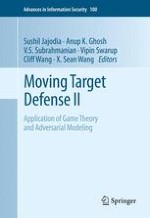2013 | OriginalPaper | Buchkapitel
6. Applying Self-Shielding Dynamics to the Network Architecture
verfasst von : Justin Yackoski, Harry Bullen, Xiang Yu, Jason Li
Erschienen in: Moving Target Defense II
Verlag: Springer New York
Aktivieren Sie unsere intelligente Suche, um passende Fachinhalte oder Patente zu finden.
Wählen Sie Textabschnitte aus um mit Künstlicher Intelligenz passenden Patente zu finden. powered by
Markieren Sie Textabschnitte, um KI-gestützt weitere passende Inhalte zu finden. powered by
